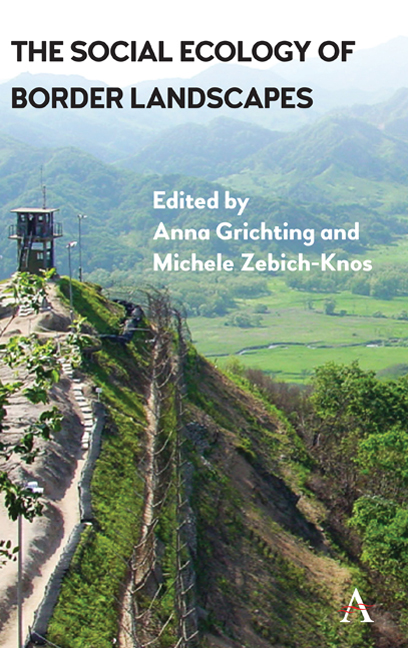Book contents
- Frontmatter
- Contents
- List of Illustrations
- Preface
- List of Contributors
- Introduction: Social Ecologies and Borderlands
- Part I FRAMES: MAPPING SOCIAL ECOLOGIES IN BORDER TERRITORIES
- Part II BRIDGES: RESILIENCE, RESTORATION AND RECLAMATION
- Chapter Four Borders as Zones of Experiential Learning: The Case of the Balkans Peace Park Project
- Chapter Five Social Ecologies in Borderlands: Crane Habitat Restoration and Sustainable Agriculture Project in the Democratic People's Republic of Korea
- Chapter Six Socio-ecological Transformations in Riparian Zones: The Production of Spaces of Exclusion and the Uneven Development of Resilience in the Sonoran Borderlands
- Chapter Seven From No-Man's Land to Every-Man's Land: Socio-ecological Approaches to Reclaiming Shared Spaces in Border Landscapes, with Examples from Germany and Cyprus
- Part III CORRIDORS: CATALYSTS AND COLLABORATION IN CONFINED SPACES
- Part IV PORTALS: DIALOGUE, EXCEPTION AND RETERRITORIALIZATION
- Conclusion: Making Sense of Social Ecology, Borders and the Environment
- Index
Chapter Six - Socio-ecological Transformations in Riparian Zones: The Production of Spaces of Exclusion and the Uneven Development of Resilience in the Sonoran Borderlands
from Part II - BRIDGES: RESILIENCE, RESTORATION AND RECLAMATION
Published online by Cambridge University Press: 10 January 2018
- Frontmatter
- Contents
- List of Illustrations
- Preface
- List of Contributors
- Introduction: Social Ecologies and Borderlands
- Part I FRAMES: MAPPING SOCIAL ECOLOGIES IN BORDER TERRITORIES
- Part II BRIDGES: RESILIENCE, RESTORATION AND RECLAMATION
- Chapter Four Borders as Zones of Experiential Learning: The Case of the Balkans Peace Park Project
- Chapter Five Social Ecologies in Borderlands: Crane Habitat Restoration and Sustainable Agriculture Project in the Democratic People's Republic of Korea
- Chapter Six Socio-ecological Transformations in Riparian Zones: The Production of Spaces of Exclusion and the Uneven Development of Resilience in the Sonoran Borderlands
- Chapter Seven From No-Man's Land to Every-Man's Land: Socio-ecological Approaches to Reclaiming Shared Spaces in Border Landscapes, with Examples from Germany and Cyprus
- Part III CORRIDORS: CATALYSTS AND COLLABORATION IN CONFINED SPACES
- Part IV PORTALS: DIALOGUE, EXCEPTION AND RETERRITORIALIZATION
- Conclusion: Making Sense of Social Ecology, Borders and the Environment
- Index
Summary
Uneven development is the hallmark of the geography of capitalism. […] It is the geographical expression of the contradictions inherent in the very constitutions and structure of capital.
In August 2014, the Buenavista del Cobre copper mine, owned and operated by Grupo México, the third largest copper producer worldwide, with 2012 sales of more than $10 billion, experienced a major tailings dam collapse. The resulting spill caused 40,000 cubic meters of toxic sulphuric acid and heavy metals to spill into the Rio Sonora, which flows south from its headwaters in Cananea into the capital city of Hermosillo. Following the spill, 22,000 people in seven towns were left without access to water. Exposure to the polluted water also proved devastating for livestock and agricultural operations, damaged the local riparian ecology and caused wildlife mortalities. Hardly one month later in September 2014, the Buenavista del Cobre mine experienced a second spill, this time sending water contaminated with toxic tailings materials into the binational San Pedro River (Figure 6.1)
The San Pedro River flows north from its headwaters in the mountains near Cananea, crossing the international border and flowing into Arizona. In light of the spills, there have been calls throughout Sonora and beyond, even echoing in the chambers of Mexico's national congress, to cancel Grupo México's concession to operate the Buenavista del Cobre mine in Cananea. However, the cancelation of the concession is highly unlikely due to the strong relations of economic and political dependence between Grupo México and the Mexican government.
The power the mine wields over local land and water resources today represents a major shift from previous arrangements of power in rural Sonora, organized around populist agrarian reform. On February 4, 1959, an unusual delegation of high-level Mexican officials convened on the rural outskirts of Cananea, Sonora, less than 100 kilometers from the US border. Gathering on the Martinez Ranch, surrounded by the golden grasslands and forested riparian corridors of the San Pedro River and its tributaries, the president of Mexico, Adolfo López Mateos, the governor of the state of Sonora, and the leaders of the nation's Department of Agriculture stood before a crowd of hundreds. López Mateos, barely two months into his presidency, stepped forward to greet the assembled landless peasants, ranchers, agrarian reform leaders and local mine laborers.
- Type
- Chapter
- Information
- The Social Ecology of Border Landscapes , pp. 107 - 130Publisher: Anthem PressPrint publication year: 2017



